Text
Week of 4/9-13
These past two weeks I have worked on finalizing the end product of my vision for this piece. In the upcoming week, I want to have a final cut list of the wood I am going to need in order to create this project so that I can start putting some of it together. I have decided on using wood and translucent tracing paper to build this project and that I will be taking up the space in the foyer for installation.
I am drawing inspiration from Bjarke Ingels who made a giant maze. The thing that I am referencing the most is the decline in height of the space she used. Because I have a limited amount of space and materials, I will have a less gradual and graceful design but the outside of the structure will begin tall and will come down to about 3 feet tall.
0 notes
Text
Week of 3/26: Check-In
In the duration of the past week, I created four different models that each encompass a certain feeling or sensation that I hope to have in my final version.


Model 1: This is the simplest one, mainly because it was the first one and I wanted to try just zeroing in on one part of a maze and so this was the product. Though it does not have much to it, it did let me entertain the idea of having a structure that is not just a box, it’s also a wide plan so there is the opportunity to add walls in different places if I chose to advance with this model.


Model 2: Though I said I did not want to do anything boxy, but I figured that it would be a good idea to at least see what this layout would look like and play more with placements of walls and how covering certain paths with a foot of extra wall could trick someone into taking another path, especially in an environment with low to little light.


Model 3: This model is a simpler version of the previous one, mixed with some variations in the shape. This model also plays with changing the height of the maze as the it nears the end.


Model 4: This model derives a bit from the others and overall combines aspects for all of them into one. This model is in the shape of a C and doesn’t really have a maze-y element to it, but the change in height is more prominent in this model, creating a more constricting feeling for people as they get closer to the end, making it seems as if they’re really on a ride, not really making their own decisions which is something that I really like since people in situations in which they are not a permanent citizen kinda just have to go with the flow and deal with whatever life throws at them.
0 notes
Text
This Week: 3/19-3/23
I want to further develop my plan for this project. Through break, I conjured up an idea that bounces off of both initial plan and the plan formulated during my talk with mr Harrison in class. I want to make something that mimics the experience young men would have as an initiation ceremony in Chavin de Huantar and mix it with an experience my mother talked about. When she moved to this country, she was not planning on dealing with the deaths of those who she loved, and not being able to do anything about it. Therefore, when her best friend passed away, she was kept out of the loop and found out 10 years after, describing it as if she was lost in a dark tunnel and being able to see peeks of light from time to time until she realised that the light at the end of her tunnel was a speeding train of lies and depression. There is a ballad from an artist who she dedicated to the memory of her friend and I plan to take the lyrics apart and use the song itself or use it as inspiration to inject sound into the meze-like tunnel structure I plan to build. So this week I will create some possible plans (maybe 5-10 different version) and then see how noise sources can be places to create a eere and dreadful effect.
0 notes
Text
Initial Proposal
INTENT: Describe the concentration project you want to pursue in a paragraph with a thesis statement (your intention). Then describe the medium, scale, and number of pieces you want to complete.
I plan on using this medium to create a space in which my audience is seemingly transported into another realm, as the real stained glass windows intended to in the cathedrals and churches made during the Gothic and Romanesque periods. I hope to improve my use of light manipulation and colour to both set a mood and deliver a narrative in a way that is not so literal and leaves just enough room for the viewer to have a personal experience with the piece yet not be ambiguous to the point of it just being a window with pretty colours on it. Ideally, I would like to use a hallway or a semi-lengthy stretch of wall in which the colours used can translate well, so in contrast to my giant circular piece in the window, this project would be a series of small squares, about 22”x22” to match the size of the windows in Swig. However, it would be interesting to try my hand at creating my own space outside of Swig that would better cater to the content of the pieces I will be producing. Creating a small room with an inner viewing area which would mask the stained glass piece yet cast the light of it onto a surface like a sheet to mimic the dark atmosphere in which stained glass windows are usually seen in order to further emphasize the colour and form choices would be an interesting challenge that would force me to get out of the usual spaces in Swig and create something in a fresh and relatively alien space.
0 notes
Text
NYC Met Museum Winter 2018
The following is a collection of notes about pieces I came across in the Met this past trip (Wednesday 31 January 2017), and what ideas these pieces inspired.
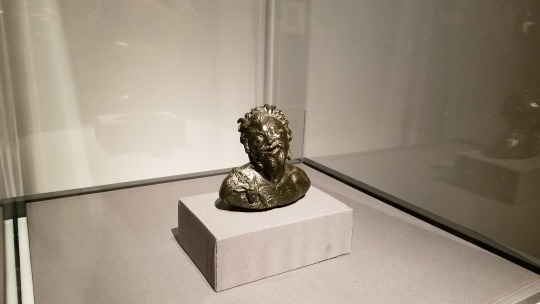
1. Bust of a Satyr. Poggio a Caiano and Michelangelo. Florence c.1440.bronze.
This piece was against a wall in a relatively dark part of the gallery, and was so small it could have been mistaken for shapeless rock from just 5 feet away. Upon closer inspection, the bust really captured my attention because of the facial features. I was--and still am--unsure of the expression this man wears on his face; to me he looks gleeful and full of life, as if he were frozen mid-laugh, but to my partner, he looked disgusted with a wretched scowl adorning his lips, beard wild from anger. Its small scale reminded me of a collection a few years ago from the Guggenheim that was a joint project between Peter Fischli and David Weiss that captured small moments in time and added some sort of humor to it. This may lead me into pursuing some sort of project dealing with a malleable material and the mixture of small things coming together to make a bigger thing, almost like a mandala where layers of small details add up to a larger, beautiful image.
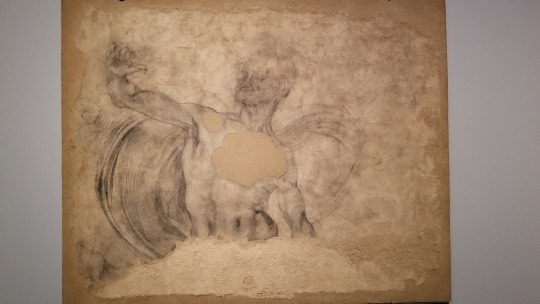
2. Mural Fragment of a Male Mide in Three-Quarter Length. Michelangelo.
This was from a special exhibit that focused on the masterpieces of the sistine chapel painted by Michelangelo. This struck me as particularly interesting because the face looks like that of an older man, yet he has the body of a fit, young man. I am unsure of this image’s relationship to the ceiling of the SIstine Chapel, the delicacy and attention to detail are stunning. The smooth and graceful flow of the man’s robes as he moves is very elegant; from the pieces I have done this year and the year before which dealt with movement, I have never been able to capture the refined lines of a cloth or garment. Of course this is stylized, but I would like to further experiment with long exposure shots or even possibly photoshop to create something more similar to this static movement that is so often portrayed in Michelangelo’s painted works.
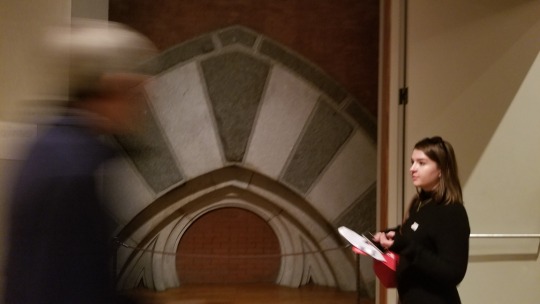
3. Arch from the Original Building’s Fifth Avenue Facade(+museum buddy).Calvert Vaux and Jacob Wrey Mould.c.1880
This little fragment of the museum’s past was tucked into a quiet, dark corner where only those who walked slowly enough would notice it. As you can see from the close proximity of the door to the right of the arch, it is not an element of the hallway that is very much presented as a primary attraction, which, just like the Bust of a Satyr, successfully captured my attention. After spending months learning about the facades of buildings of ancient peoples and cultures very much foreign to us, I have grown to pay more attention to the outward appearance of buildings (in this case no to outward). The seemingly segmented-arch with its circular elements caught my attention because it shared characteristics with the earliest from of open-spandrel segmented arched from china as well as the pointed features of an Islamic mihrab, and possibly even a hint of early gothic elements. This made me think about how crossing cultures (something that was done with religions in the early renaissance) can produce an end result that is more beautiful than it would have been had it been made up solely of one culture’s ideals. I have been working for a few years now with motifs and traditions revolving my culture, so trying to branch out more and include other elements from other cultures that are close to me (i.e. Arabic/Turkish) could create a wonderful contrast in the designs of my future compositions.
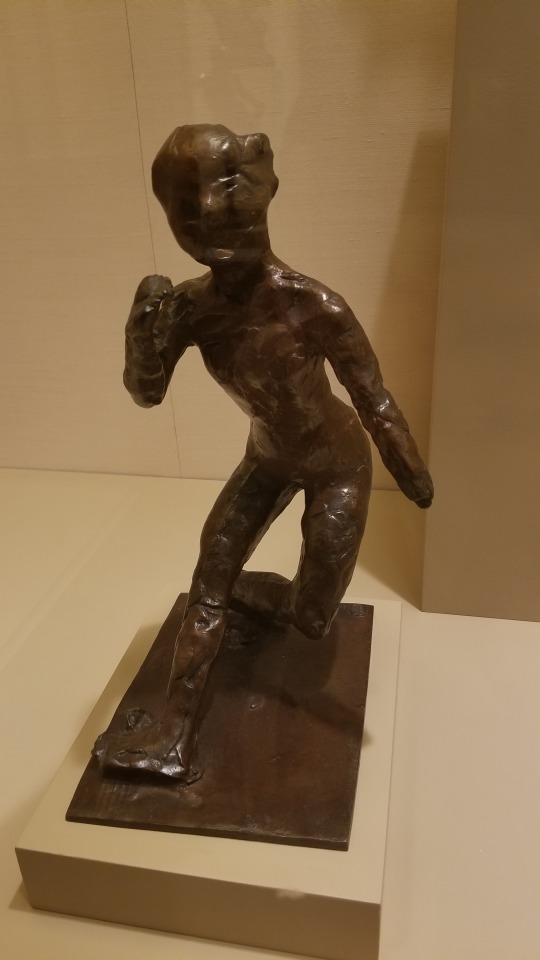
4. The Bow. Cast (in c. 1920) from a wax sculpture made c. 1896-99. bronze. This piece was in a separate gallery with other figures cast in bronze that had were posed in different dance-like movements. Many of them were similar but varied in size. This one caught my attention because it was somewhat more crude looking than the other statues in the gallery. The idea that something as graceful as a bow is presented in a way that is so loose and rough was very interesting and once again reminded me about the Peter Fischli and David Weiss collection because they had a very loose form much like this one.
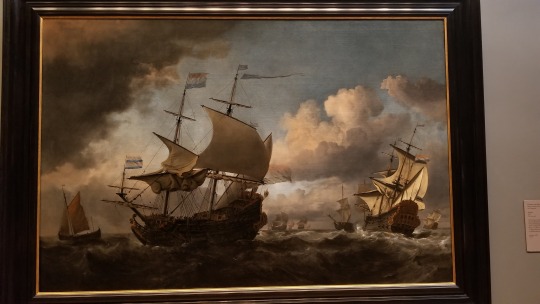
5. The Dutch Fleet Assembling Before the Four Day’s Battle. Willem van de Velde II. c.1670.oil on canvas.
The delicacy and elecancy of this piece captivated me. The lighting, which emphasises the ship in the background more so than the one closest to us reminds me of photographs were a framing technique is that of using an object that is closer to the viewer, blurring it and then making it darker than the object farther away from us than the closer one. The warm colour pallet is also one I would like to play more with because I have found that throughout my time working with photography, I have been drawn to blue hues and cooler tones more than the warmer, dusty colours. Overall, this introduces the challenge of working with a different colour pallet, movement and lighting (when referring to photography).
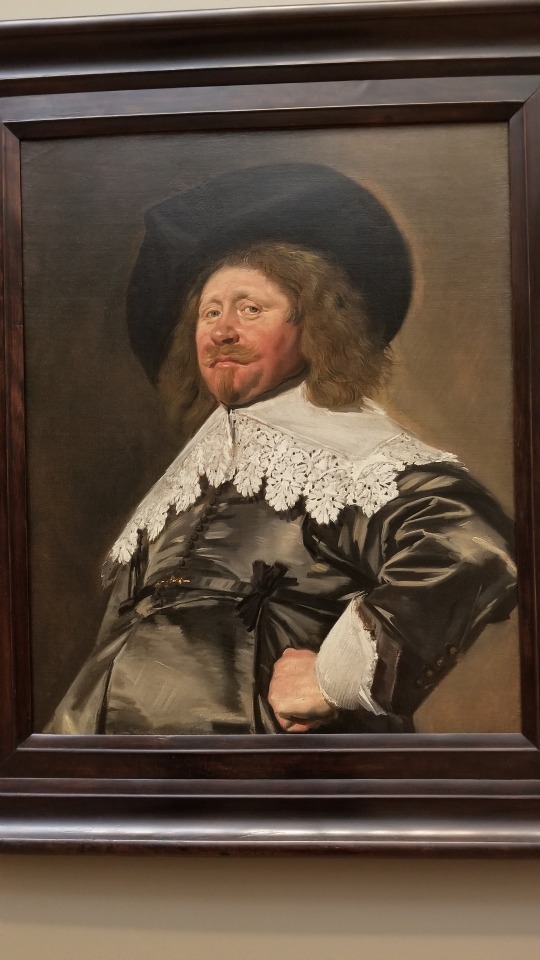
6. Portrait of a Man, Possibly Nicolaes Pietersz Duyst van Voorhout. Frans Hals. c.1636-38. oil on canvas.
This piece, much like the previous, has a warmer colour pallet that I would really like to work more with. The expression of the man is also very interesting, he adaps a pseudo contrapposto, instead of being a typical portrait, which has a very stoic and static representation of a person, this presents the viewer with a more playful and animated view of the person in the painting. His seemingly standoffish expression changes when the viewer looks at the bigger picture: his hair is unruly and his face is flushed, almost as if this man was caught in the middle of boasting drunkenly about how richt and powerful he is. The simplicity of his garments also forces the viewer to pay more attention to the face, letting the viewers decide for themselves if he is trying to act above those around him or if he is an approachable fellow that likes standing a little funny.
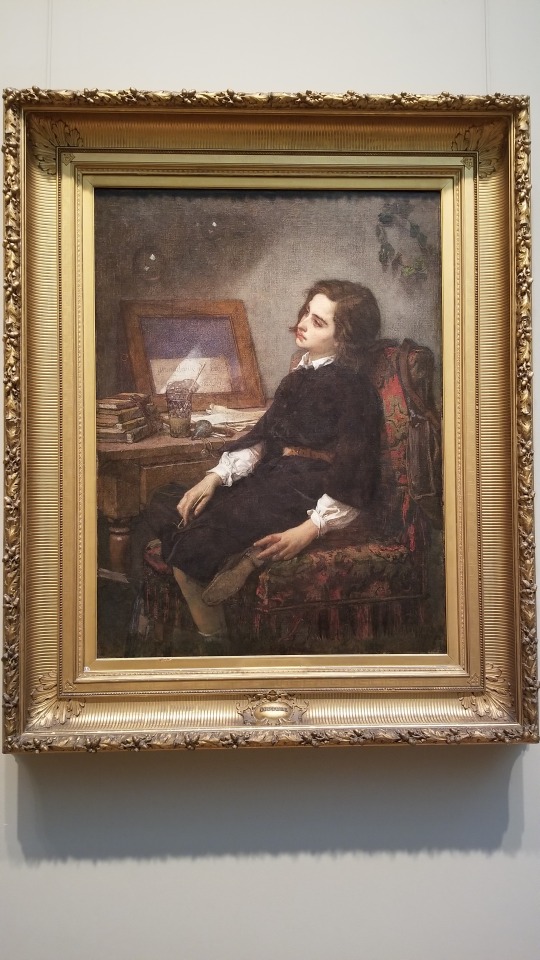
7. Soap Bubbles. Thomas Couture. c.1859. oil on canvas
The first time I saw this, I thought it was a young girl who was caught daydreaming, but when I read the description provided by the museum, I learned that it was actually a young schoolboy who is contemplating the transience of life which is interesting because he is so young and is thinking, essentially, about death and the mortality of man. Creating pieces that have underline messages is difficult because, just like I did, viewers may not perceive the piece the way the artists intends for it to be. Just like my rose window piece, which was titled 558 to commemorate the victims of the Las Vegas shooting, the piece is not always read the way it was intended to. I want to challenge myself to work more on creating an easier way for viewers to understand what I am trying to convey without resorting to cliche elements.
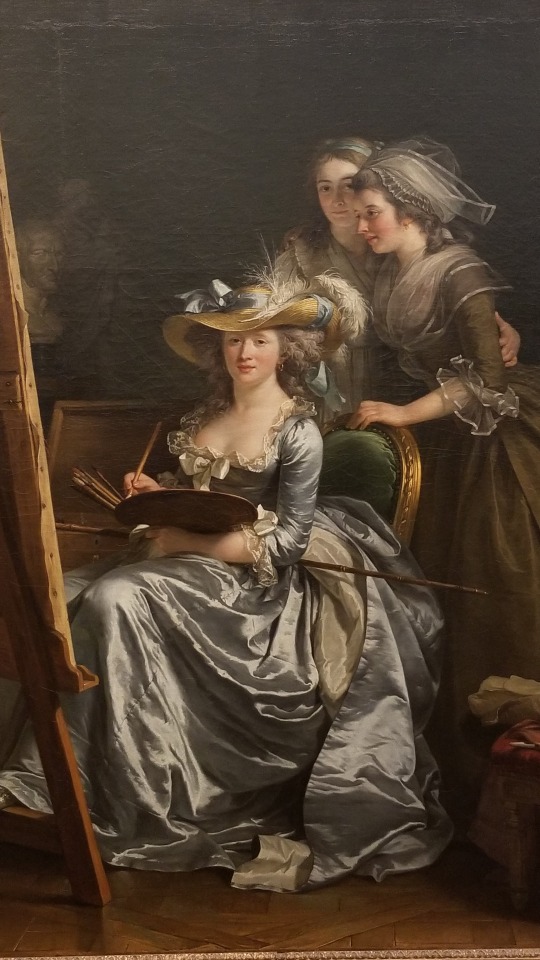
8. Self Portrait with Two Pupils, Marie Gabrielle Capet and Marie Marguerite Carreaux de Rosemond. Adelaide Labille Guiard. c.1785. oil on canvas.
This final piece was captivating, in my opinion, because the painting is a self portrait of a female painter. In the 16th century, women were not allowed to/thought to be able to do something as complex as compose great masterpieces like those created by men. Her smug expression, as well as the inclusion of her female pupils, serve as a sort of biting of the thumb to the social norms of the time in a very humorous way. This piece was not so much inspiring in terms of the composition, but rather was interesting to me because of the smugness of the painter. With a contemporary lense, she can be seen almost as a feminist icon since what she was doing at the time would have been deemed extremely progressive.
#metropolitan museum of art#nyc trip#michelangelo#adelaide labille-guiard#the bow#frans hals#Willem van de Velde II#Poggio a Caiano#thomas couture#oil on canvas#bronze#inspiration
0 notes
Photo

THE BOW
cast in 1920 from a wax sculpture modeled c. 1896-99
bronze
part of the foundry’s series
29.100.410 (Metropolitan Museum of Art)
0 notes
Photo

SOAP BUBBLES
Tomas Couture
French, Senlis Villiers-le-Bel c. 1859
oil on canvas
Catharine Lorillard Wolfe Collection (1887)
0 notes
Photo

SELF PORTRAIT WITH TWO PUPILS, MARIE GABRIELLE CAPET AND MARIE MARGUERITE
Adelaide Lanielle Guiard
French Paris, Paris c. 1785
oil on canvas
0 notes
Photo

PORTRAIT OF A MAN, POSSIBLY NICOLAES PIETERSZ DUYST VAN VOORHOUT
Fans Hals
Dutch, ANtwerp Haarlem c. 1636-38
oil on canvas
Part of the Jules Bache Collection, (1949)
0 notes
Photo

THE DUTCH FLEET ASSEMBLING BEFORE THE FOUR DAY’S BATTLE
Willem van de Velde II
Dutch, Leiden London c. 1670
oil on canvas
Lent to the Metropolitan Museum of Art by the Moveo Art Collection
0 notes
Photo

ARCH FROM THE ORIGINAL BUILDING’S FIFTH AVENUE FACADE
Calvert Vaux & Jacob Wrey Mould
c. 1880
Metropolitan Museum of Art, New York City, New York
0 notes
Photo

MURAL FRAGMENT OF A MALE NUDE IN THREE-QUARTER LENGTH
Michelangelo
Sernesi Family Villa Michelagiolo, Settignano
charcoal on rough porous plaster
0 notes
Photo

BUST OF A SATYR
Poggio a Caiano and Michelangelo
c. 1440-45/ 1491
Museo Nazionale del Bargello, Florence
bronze.
0 notes
Photo

Crooked Beak of Heaven Mask
Kwakwaka’wakw, British Columbia
late 19th century
wood, paint, fiber, cord
Metropolitan Museum of Art
(photo by me)
0 notes
Photo


May 2017, The Art of Dead Love
Photographs by Cathy Watkins.
0 notes